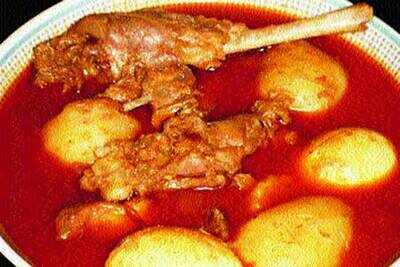Trending
This story is from November 24, 2014
The legend behind Goalondo Steamer Chicken
The chicken cooked on the Goalondo steamer has gone down in Bengali folklore. Those who have travelled this route still swear by the taste. But can it be recreated?

The chicken cooked on the Goalondo steamer has gone down in Bengali folklore. Those who have travelled this route still swear by the taste. But can it be recreated?
It all started with celebrated author and scholar Syed Mujtaba Ali, perhaps the first foodie writer of the early 20th century, throwing me a challenge. His fascinating literary musings, sooner or later, always came back to some aspect of food.Quite frankly, critical of the Bengali’s inability to cook a good meat curry, he wrote in one of his essays: “I am amazed that the young girl from Bikrampur (the women of Bikrampur were reputed to be the finest cooks in all of Bengal) travels to her college hostel in Calcutta on the Goalondo steamer, dining on rice and curry on board, yet has never been able to produce the Steamer Fowl Curry cooked by the simple boatmen!”
With roots in Dhaka, Bikrampur, these lines stuck in my head as did his observations in yet another piece — “For 30 years I have travelled on the Goalondo steamer. A few things have changed here and there but not the smell. It’s a little damp, a little musty but the overriding smell is that of the ‘murgir jhol’ being cooked by the khalasis. I have often imagined the entire steamer itself to be a giant chicken being cooked inside out, the aroma permeating the entire route from Chandpur to Narayanganj to Goalondo”. And thus started my own personal journey aboard this steamer, travelling on the Padma in the pre-Independence era, tempered with familial nostalgia and curiosity about an Undivided Bengal.
From the late 19th century, those travelling to East Bengal, Assam or Burma took the steamer from Goalondo, a small station at the confluence of the Padma and the Brahmaputra, where the Eastern Bengal Express from Sealdah terminated. The Goalondo steamer then travelled up to Narayanganj in Dacca and from thereon people moved ahead to Sylhet or Chittagong or further on into Burma on the one side and to the tea gardens of Assam on the other. An overnight journey, the ‘fowl’ curry served aboard the steamer, cooked by Muslim boatmen has gone down in Bengal’s gastronomic history and is what legends are made of. It shares a place with other historical dishes like the Dak Bungalow Chicken Curry or the Madras Club Qorma or the Railway Mutton Curry. It was a simple rustic preparation with basic spices but those who have tasted it and are still alive to talk about it, insist that they have never tasted a curry as delicious as this anywhere else. “Why?” asks one writer. No one knows, he says!
There were other things I discovered en route — that the famed Smoked Hilsa or the Bhetki was born aboard these steamers, carried to the Raj Kitchens of Calcutta by the highly skilled Mog Barua cooks. Or that first-class passengers had a choice of the Fowl Curry or the Anglo-Indian creation, Country Captain. Or that the Naf River Steamer, plying between Chittagong and Burma, still serves such a curry. It is this that I call Heritage cuisine, a back-to-our-roots experience that I hope to showcase at the Goalondo Steamer Pop-Up at Ta’aam restaurant in Calcutta on July 27, 1 pm.
The pop up offers not only the fowl curry made with country chicken as it was in those days of yore but smoked fish as well, done in just the way they did it when the Mogs hijacked it for the Sahibs! The meal carries you through the route that the steamer serviced, incorporating dishes from deep Dhaka, influences from Sylhet, a bit of a subaltern touch from the Khasi tribe of the Sylhet hills, crossing the Chittagong hills into Burma and comes back to Calcutta with a bowl of 19th century history by way of Colonel Skinner’s chutney and the famed 1st Bengal Cavalry. It’s about heritage and history on your plate.
By Pritha Sen
A consultant in the social development sector, Delhi-based Pritha Sen loves to deconstruct the history, influences and origins of the legacy of food passed down to us by our mothers.
It all started with celebrated author and scholar Syed Mujtaba Ali, perhaps the first foodie writer of the early 20th century, throwing me a challenge. His fascinating literary musings, sooner or later, always came back to some aspect of food.Quite frankly, critical of the Bengali’s inability to cook a good meat curry, he wrote in one of his essays: “I am amazed that the young girl from Bikrampur (the women of Bikrampur were reputed to be the finest cooks in all of Bengal) travels to her college hostel in Calcutta on the Goalondo steamer, dining on rice and curry on board, yet has never been able to produce the Steamer Fowl Curry cooked by the simple boatmen!”
With roots in Dhaka, Bikrampur, these lines stuck in my head as did his observations in yet another piece — “For 30 years I have travelled on the Goalondo steamer. A few things have changed here and there but not the smell. It’s a little damp, a little musty but the overriding smell is that of the ‘murgir jhol’ being cooked by the khalasis. I have often imagined the entire steamer itself to be a giant chicken being cooked inside out, the aroma permeating the entire route from Chandpur to Narayanganj to Goalondo”. And thus started my own personal journey aboard this steamer, travelling on the Padma in the pre-Independence era, tempered with familial nostalgia and curiosity about an Undivided Bengal.
From the late 19th century, those travelling to East Bengal, Assam or Burma took the steamer from Goalondo, a small station at the confluence of the Padma and the Brahmaputra, where the Eastern Bengal Express from Sealdah terminated. The Goalondo steamer then travelled up to Narayanganj in Dacca and from thereon people moved ahead to Sylhet or Chittagong or further on into Burma on the one side and to the tea gardens of Assam on the other. An overnight journey, the ‘fowl’ curry served aboard the steamer, cooked by Muslim boatmen has gone down in Bengal’s gastronomic history and is what legends are made of. It shares a place with other historical dishes like the Dak Bungalow Chicken Curry or the Madras Club Qorma or the Railway Mutton Curry. It was a simple rustic preparation with basic spices but those who have tasted it and are still alive to talk about it, insist that they have never tasted a curry as delicious as this anywhere else. “Why?” asks one writer. No one knows, he says!
I took up the author’s challenge by talking to the generation who had travelled the route — grandparents, grand-aunts, aunts and mothers, getting a description of the look and taste, if not the recipe. I trawled through realms of historical data and found mention of it everywhere — in the Bengal Gazette, Imperial Gazeteer, in old journals of tea planters and forest rangers, in documents related to the erstwhile Imperial Railways and the Joint Steamer Company and, of course, Bengali literature. One common thread running through was that it was a “fiery, thin red curry with oil floating on top.” In some cases, I found it was also cooked with eggs and potatoes. For three years I tried out all the inputs I got, beginning with the basic “it was nothing but a rustic curry made from grated onions, garlic, ginger and lots of chilies and mustard oil.” No harm in that but meat curries all over rural Bengal are cooked exactly like this even to this day and what Syed Mujtaba bemoans! So what was the oomph factor?
There were other things I discovered en route — that the famed Smoked Hilsa or the Bhetki was born aboard these steamers, carried to the Raj Kitchens of Calcutta by the highly skilled Mog Barua cooks. Or that first-class passengers had a choice of the Fowl Curry or the Anglo-Indian creation, Country Captain. Or that the Naf River Steamer, plying between Chittagong and Burma, still serves such a curry. It is this that I call Heritage cuisine, a back-to-our-roots experience that I hope to showcase at the Goalondo Steamer Pop-Up at Ta’aam restaurant in Calcutta on July 27, 1 pm.
The pop up offers not only the fowl curry made with country chicken as it was in those days of yore but smoked fish as well, done in just the way they did it when the Mogs hijacked it for the Sahibs! The meal carries you through the route that the steamer serviced, incorporating dishes from deep Dhaka, influences from Sylhet, a bit of a subaltern touch from the Khasi tribe of the Sylhet hills, crossing the Chittagong hills into Burma and comes back to Calcutta with a bowl of 19th century history by way of Colonel Skinner’s chutney and the famed 1st Bengal Cavalry. It’s about heritage and history on your plate.
By Pritha Sen
A consultant in the social development sector, Delhi-based Pritha Sen loves to deconstruct the history, influences and origins of the legacy of food passed down to us by our mothers.
End of Article
FOLLOW US ON SOCIAL MEDIA









